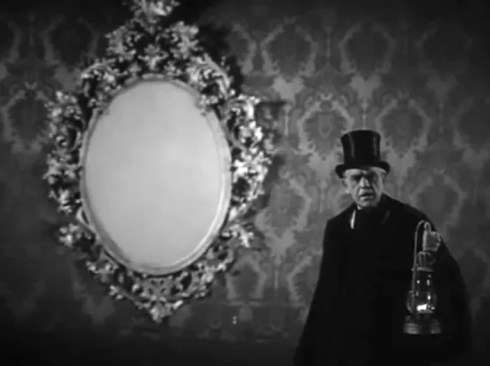Hosted By Christina Wehner & Silver Screenings
This is a Blogathon I just couldn’t resist, aside from the nifty idea, I always love the opportunity to cover one of my favorite actors… the great Boris Karloff. Corridors of Blood is a fine example of how Karloff’s benevolent charisma always manages to create a sympathetic ‘monster’ either virtual or psychologically. He appeared in several films as the altruistic scientist seeking and working toward the ultimate good, only to inadvertently create a creeping chaos unraveling in a most horrific way.

Speaking for myself and I am assured a gazillion other fans, even at his most nefarious, we never fail to align ourselves with most of Karloff’s characters, perhaps with the exception of the sadistic Mord in Tower of London (1939) and the maniacal Master George Sims in Bedlam (1946). But, for most of his performances, including his poignant portrayal of Mary Shelley’s eternally replicated monster, we began to see the depth of Karloff’s craft. It’s an art form in and of itself to be able to manifest personae that can be simultaneously benevolent and menacing, accessible and yet frightening- the ultimate anti-hero… (Vincent Price has that awesome quality as well). It is this gift that makes Karloff so beloved and so compelling to watch over and over again!
Thanks once again to Christina Wehner and Ruth from Silver Screenings for coming up with a fantastic topic and allowing me to come out and play!

From Boris Karloff More Than a Monster: The Authorized Biography by Stephen Jacobs ” The scriptwriters had the insane scientist transplant brains, hearts, lungs and other vital organs. The cycle ended when they ran out of parts of anatomy that could be photographed decently.” Boris Karloff (1962)
CORRIDORS OF BLOOD (1958)
Source: From A Day-by Day Guide to 366 Horror Films -A Year of Fear by Bryan Senn: According to Senn’s marvelous book that includes some wonderful obscure gems, Corridors of Blood (1958) was promoted with this sensationalist trailer-
“You’ll take shock after shock after shock! Don’t hold in your terror; shriek if you must!”
And this quite sobering historical horror/melodrama at times does create several shocking moments, acid thrown in someone’s face, defenestration that result in death by impalement, asphyxiation by pillow, & surgical amputation without anesthesia.

Produced by John Croydon, and directed by Robert Day, The Haunted Strangler and Corridors of Blood were shot back to back and released both in 1958.
Directed by Robert Day (First Man into Space 1959, SHE 1965, slew of superior tv movies such as, The House on Green Apple Road 1970, Ritual of Evil 1970, In Broad Daylight 1971, The Initiation of Sarah 1978 and television dramas: The Streets of San Francisco, The Name of the Game, Circle of Fear, Police Story, McCloud, The Sixth Sense, The Bold Ones, Bracken’s World, & Ironside.)
Corridors of Blood stars Boris Karloff as the kindly Dr. Thomas Bolton, Francis Matthews as Jonathan Bolton, Betta St. John as Jonathan’s girlfriend Susan, a standout performance by Christopher Lee as Resurrection Joe, a surly and imposing agent of death!

Adrienne Corri (Doctor Zhivago 1965, A Clockwork Orange 1971, Vampire Circus 1972, Madhouse 1974) as Rachel : “Some day you’ll wiggle that bottom of yours just once too often.” speaking to Yvonne Romain (Circus of Horror 1960, Curse of the Werewolf 1961, Night Creatures 1962), as Rosa. Carl Bernard as Ned, the Crow and Francis De Wolff as Black Ben –all dwellers of The Seven Dials.

Buxton Orr (Fiend Without A Face 1958, First Man Into Space 1959, Suddenly, Last Summer 1959, Doctor Bloods Coffin 1961 and The Snake Woman 1961) is responsible for the music– a dark and threatening score that underlies some of the more disturbing scenes. Cinematographer Geoffrey Faithfull, (Village of the Damned 1960, Murder She Said 1961, Panic 1963) has done a marvelous job of creating a shadowing world lit with menacing ambiance.
Absent is the traditional monster terrorizing the villagers in the picture, it is more centered around the doctor/scientist who is at the heart of the narrative and his scholarly & personal struggle to find answers hidden in the world of science and medicine. The film opens with the inhabitants of The Seven Dial’s tavern hearing the bell ringer summon the doctor to surgery. The whole effect is very reminiscent of a darkly melancholy Lewtonesque panorama. Once the bell peels throughout the town, even the butcher stops his very aptly to the scene, hacking away at the meat on his table in order to follow to hospital and the operating theater. The camera close up on the door might as well say ‘welcome to hell.’
Continue reading “Movie Scientist Blogathon 2016- The Menacing Altruism of Boris Karloff!”


















































































































































